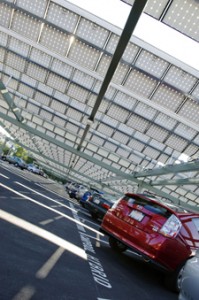“The electric car doesn’t do any good because it’s just powered by coal” gets repeated by the oil industry, by news pundits who ignore fact checking, and even by some environmentalists.
In the past three years of writing about electric cars, I have yet to meet an electric car driver or fleet manager who only uses coal power. If you own an electric car and only use coal power, please leave a comment at the end of the article that mentions what you drive and the state in which you live. In the United States, 36 states have utility scale wind power, so the comment will not be from one of them.
In 2011, over half of the 18,000 electric cars were delivered to states that have zero coal-power plants. In 2012, 60,000 to 100,000 electric cars will be primarily be delivered in zero-coal states. My Nissan LEAF is powered by my utility PG&E with a typical California energy mix of 47% natural gas, 20% nuclear, 16% large hydro, and 15% other renewables. Yes, during peak summer afternoon demand, PG&E does import 2% coal power from other states, but I charge my electric car off-peak after 10 p.m. Many electric car drivers participate in utility programs that offer lower prices for charging off-peak.
By 2020, California utilities plan to have 33% of delivered power from renewables including wind, solar, geothermal, biomethane and waste. By 2050, SMUD, a leading utility, plans to be 90 percent renewable as it implements energy storage that enables renewables to be used 24/7 and as it implements smart grid and smart pricing to make demand more level.
Electric Cars Ride on Sunlight
Many early adopters of electric vehicles are also early adopters of solar power. Jackson Browne rides on sunlight, powering his Chevrolet Volt with the solar on his roof. At Camp Pendleton, the Marine Corp showed me their solar carport with charge units for their 291 electric vehicles used daily.
 The Renault-Nissan Alliance is leading the volume manufacturing of electric cars. The Nissan LEAF has a growing presence in the United States and Japan, the Renault Fluence in Europe and Israel. Renault is installing 55 MW of solar parking structures at its manufacturing sites. Solar parking structures increasingly include electric car charging.
The Renault-Nissan Alliance is leading the volume manufacturing of electric cars. The Nissan LEAF has a growing presence in the United States and Japan, the Renault Fluence in Europe and Israel. Renault is installing 55 MW of solar parking structures at its manufacturing sites. Solar parking structures increasingly include electric car charging.
With plans for 250 more charging stations on its campus, and a goal to make 5 percent of its campus parking EV-ready, Google’s installation is the largest workplace charging installation for electric vehicles in the country. Much of the charging is done with renewable energy, including Google’s solar covered parking. No coal power is used in charging vehicles. Google has invested over one billion dollars in renewable energy, accelerating development of 1.7 GW of RE.
There are valid concerns about coal powered electric cars. Coal is used for about 45 percent of U.S. electricity generation. Legacy plants will continue to run for decades. An electric car is over 5 times as efficient as a typical gasoline car, so even when coal-power is used lifecycle greenhouse gas emissions are less from the electric car. A typical electric car, however, is only 2.5 times as efficient as the best hybrids such as the Toyota Prius. If your utility bill shows that 90 percent of your electricity comes from coal, you might do as much good with a hybrid that gets over 40 mpg as with an electric car.
The coal concern is greater in China, although current plans call for China to implement more wind and solar power than now exists in all other countries.
By the time that we have millions of electric vehicles on the road, coal will play a smaller role in our energy mix. Coal mining operations and coal-power plants will be asked to capture emissions or pay a percentage of the health damage and climate damage that they cause. When the EPA publishes new rules there will be a coal and electricity utility outcry to shutdown the EPA and save our economy. Yet, playing buy the rules will create new opportunities for energy efficiency technology, energy management, renewable energy, and efficient natural gas plants that will boost the economy.
What would you do if you were an electric utility CEO deciding on a billion dollar plant to run 40 years or more? Coal keeps getting more expensive. Natural gas, wind, solar, and energy storage and demand response keep getting less expensive.
Who Will Try to Kill the Electric Car?
Congressman Edward J. Markey, a senior member of the House Energy and Commerce Committee, stated, “The fossil-fuel industry and its allies in Congress see the solar and wind industries as a threat and will try to kill these industries as they have for the preceding two generations,” Markey says. (From Juliet Eilperin’s article in Wired)
The electric car and renewable energy are a long-term threat to the oil industry who will lobby fiercely to eliminate tax breaks for solar, wind and EVs, while fighting to protect the billions of tax breaks that allowed Exxon to pay zero income tax last year while earning tens of billions. We are a vulnerable nation with 98 percent of our transportation being fueled by oil refined gasoline, diesel, and jet fuel.
You can turn on Fox News and watch Chevrolet be attacked because in a crash test on Chevy Volt caught fire 5-days after the test. You won’t hear much about the 180,000 gasoline cars that caught fire after crashes in 2011. Solar bankruptcies such as Solyndra, Evergreen, and Solar Millennium will be replayed over and over. Less airplay will be given to the intense competitive progress that has made solar power 100 times less expensive than 40 years ago and fueled an industry growth of over 30 percent annually for decades.
A few years ago when a delegation of senior Chinese officials was visiting Silicon Valley, I was asked to give a talk about marketing strategy. I was asked, “What is the secret of Silicon Valley.” I answered that great innovation is possible when you’re not afraid of failure.
American innovators are working day and night from California to New York and from Michigan to Tennessee. Breakthroughs are being nurtured to commercial success in IT cloud services, RE financial services, energy efficient motors and buildings, electric batteries and electric cars. Yes, there will be more failure than success, duds will get more news time than dynamos, but the innovations that transform our lives for the better will triumph.
In the future, we will increasingly ride in electric vehicles smart charged with renewable energy.
Top 10 Electric Cars


China will be using an aggressive feed in tariff to expand their consumer owned solar rooftop installations. They are looking at several GW per year to be built across the country. They will be riding around on the free energy of the sun long before Americans will. This will also increase the GDP, jobs, as well as the quality of life for its citizens.
America could have developed both technologies side by side (electric vehicles and solar) a long time ago, but the method of funding our lawmaking system is seriously flawed (with oil/dirty energy soaked funding).